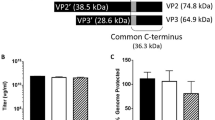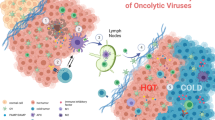Abstract
We previously reported the development of a prototype ‘oncolytic Sendai virus (SeV) vector’ formed by introducing two major genomic modifications to the original SeV, namely deletion of the matrix (M) gene to avoid budding of secondary viral particles and manipulation of the trypsin-dependent cleavage site of the fusion (F) gene to generate protease-specific sequences. As a result, the ‘oncolytic SeV’ that was susceptible to matrix metalloproteinases (MMPs) was shown to selectively kill MMP-expressing tumors through syncytium formation in vitro and in vivo. However, its efficacy has been relatively limited because of the requirement of higher expression of MMPs and smaller populations of MMP-expressing tumors. To overcome these limitations, we have designed an optimized and dramatically powerful oncolytic SeV vector. Truncation of 14-amino acid residues of the cytoplasmic domain of F protein resulted in dramatic enhancement of cell-killing activities of oncolytic SeV, and the combination with replacement of the trypsin cleavage site with the new urokinase type plasminogen activator (uPA)-sensitive sequence (SGRS) led a variety of human tumors, including prostate (PC-3), renal (CAKI-I), pancreatic (BxPC3) and lung (PC14) cancers, to extensive death through massive cell-to-cell spreading without significant dissemination to the surrounding noncancerous tissue in vivo. These results indicate a dramatic improvement of antitumor activity; therefore, extensive utility of the newly designed uPA-targeted oncolytic SeV has significant potential for treating patients bearing urokinase-expressing cancers in clinical settings.
This is a preview of subscription content, access via your institution
Access options
Subscribe to this journal
Receive 12 print issues and online access
$259.00 per year
only $21.58 per issue
Buy this article
- Purchase on Springer Link
- Instant access to full article PDF
Prices may be subject to local taxes which are calculated during checkout






Similar content being viewed by others
References
Aghi M, Martuza RL . Oncolytic viral therapies—the clinical experience. Oncogene 2005; 24: 7802–7816.
Bell J . Replicating oncolytic virus therapeutics—Third International Meeting. IDrugs 2005; 8: 360–363.
Tashiro M, McQueen NL, Seto JT . Determinants of organ tropism of sendai virus. Front Biosci 1999; 4: D642–D645.
Li HO, Zhu YF, Asakawa M, Kuma H, Hirata T, Ueda Y et al. A cytoplasmic RNA vector derived from nontransmissible Sendai virus with efficient gene transfer and expression. J Virol 2000; 74: 6564–6569.
Inoue M, Tokusumi Y, Ban H, Kanaya T, Shirakura M, Tokusumi T et al. A new Sendai virus vector deficient in the matrix gene does not form virus particles and shows extensive cell-to-cell spreading. J Virol 2003; 77: 6419–6429.
Inoue M, Tokusumi Y, Ban H, Shirakura M, Kanaya T, Yoshizaki M et al. Recombinant Sendai virus vectors deleted in both the matrix and the fusion genes: efficient gene transfer with preferable properties. J Gene Med 2004; 6: 1069–1081.
Yoshizaki M, Hironaka T, Iwasaki H, Ban H, Tokusumi Y, Iida A et al. Naked Sendai virus vector lacking all of the envelope-related genes: reduced cytopathogenicity and immunogenicity. J Gene Med 2006; 8: 1151–1159.
Kinoh H, Inoue M, Washizawa K, Yamamoto T, Fujikawa S, Tokusumi Y et al. Generation of a recombinant Sendai virus that is selectively activated and lyses human tumor cells expressing matrix metalloproteinases. Gene Therapy 2004; 11: 1137–1145.
Rein A, Mirro J, Haynes JG, Ernst SM, Nagashima K . Function of the cytoplasmic domain of a retroviral transmembrane protein: p15E-p2E cleavage activates the membrane fusion capability of the murine leukemia virus Env protein. J Virol 1994; 68: 1773–1781.
Cathomen T, Naim HY, Cattaneo R . Measles viruses with altered envelope protein cytoplasmic tails gain cell fusion competence. J Virol 1998; 72: 1224–1234.
Ke SH, Coombs GS, Tachias K, Corey DR, Madison EL . Optimal subsite occupancy and design of a selective inhibitor of urokinase. J Biol Chem 1997; 272: 20456–20462.
Springfeld C, von Messling V, Frenzke M, Ungerechts G, Buchholz CJ, Cattaneo R . Oncolytic efficacy and enhanced safety of measles virus activated by tumor-secreted matrix metalloproteinases. Cancer Res 2006; 66: 7694–7700.
Ke SH, Coombs GS, Tachias K, Corey DR, Madison EL . Optimal subsite occupancy and design of a selective inhibitor of urokinase. J Biol Chem 1997; 272: 20456–20462.
Ding L, Coombs GS, Strandberg L, Navre M, Corey DR, Madison EL . Origins of the specificity of tissue-type plasminogen activator. Proc Natl Acad Sci USA 1995; 92: 7627–7631.
Egeblad M, Werb Z . New functions for the matrix metalloproteinases in cancer progression. Nat Rev Cancer 2002; 2: 161–174.
Dano K, Behrendt N, Hoyer-Hansen G, Johnsen M, Lund LR, Ploug M et al. Plasminogen activation and cancer. Thromb Haemost 2005; 93: 676–681.
Gage PJ, Levine M, Glorioso JC . Syncytium-inducing mutations localize to two discrete regions within the cytoplasmic domain of herpes simplex virus type 1 glycoprotein B. J Virol 1993; 67: 2191–2201.
Tahara M, Takeda M, Yanagi Y . Altered interaction of the matrix protein with the cytoplasmic tail of hemagglutinin modulates measles virus growth by affecting virus assembly and cell-cell fusion. J Virol 2007; 81: 6827–6836.
Johnson KJ, Peng KW, Allen C, Russell SJ, Galanis E . Targeting the cytotoxicity of fusogenic membrane glycoproteins in gliomas through protease-substrate interaction. Gene Therapy 2003; 10: 725–732.
Allen C, McDonald C, Giannini C, Peng KW, Rosales G, Russell SJ et al. Adenoviral vectors expressing fusogenic membrane glycoproteins activated via matrix metalloproteinase cleavable linkers have significant antitumor potential in the gene therapy of gliomas. J Gene Med 2004; 6: 1216–1227.
Harris JL, Backes BJ, Leonetti F, Mahrus S, Ellman JA, Craik CS . Rapid and general profiling of protease specificity by using combinatorial fluorogenic substrate libraries. Proc Natl Acad Sci USA 2000; 97: 7754–7759.
Bateman AR, Harrington KJ, Kottke T, Ahmed A, Melcher AA, Gough MJ et al. Viral fusogenic membrane glycoproteins kill solid tumor cells by nonapoptotic mechanisms that promote cross presentation of tumor antigens by dendritic cells. Cancer Res 2002; 62: 6566–6578.
Diaz RM, Bateman A, Emiliusen L, Fielding A, Trono D, Russell SJ et al. A lentiviral vector expressing a fusogenic glycoprotein for cancer gene therapy. Gene Therapy 2000; 7: 1656–1663.
Linardakis E, Bateman A, Phan V, Ahmed A, Gough M, Olivier K et al. Enhancing the efficacy of a weak allogeneic melanoma vaccine by viral fusogenic membrane glycoprotein-mediated tumor cell–tumor cell fusion. Cancer Res 2002; 62: 5495–5504.
Niwa H, Yamamura K, Miyazaki J . Efficient selection for high-expression transfectants with a novel eukaryotic vector. Gene 1991; 108: 193–199.
Heussen C, Dowdle EB . Electrophoretic analysis of plasminogen activators in polyacrylamide gels containing sodium dodecyl sulfate and copolymerized substrates. Anal Biochem 1980; 102: 196–202.
Togawa D, Koshino T, Saito T, Takagi T, Machida J . Highly activated matrix metalloproteinase-2 secreted from clones of metastatic lung nodules of nude mice injected with human fibrosarcoma HT1080. Cancer Lett 1999; 146: 25–33.
Acknowledgements
This work was supported in part by Research Grants from the 21st Century Center of Excellence Program, Chiba University Graduate School of Medicine, and by Grants-in-Aid (to YY) from the Japanese Ministry of Education, Culture, Sports, Science and Technology. We thank B Moss, D Kolakofsky, I Saito and H Iba for supplying experimental materials essential for this study; K Ishida, T Kanaya, T Yamamoto, M Yoshizaki, A Tagawa, E Suzuki and N Kohno for their excellent technical assistance; and T Hironaka, T Zhu and A Iida for helpful discussions.
Author information
Authors and Affiliations
Corresponding author
Additional information
Supplementary Information accompanies the paper on Gene Therapy website (http://www.nature.com/gt)
Supplementary information
Rights and permissions
About this article
Cite this article
Kinoh, H., Inoue, M., Komaru, A. et al. Generation of optimized and urokinase-targeted oncolytic Sendai virus vectors applicable for various human malignancies. Gene Ther 16, 392–403 (2009). https://doi.org/10.1038/gt.2008.167
Received:
Revised:
Accepted:
Published:
Issue Date:
DOI: https://doi.org/10.1038/gt.2008.167
Keywords
This article is cited by
-
Oncolytic virotherapy for urological cancers
Nature Reviews Urology (2016)
-
Oncolysis by paramyxoviruses: multiple mechanisms contribute to therapeutic efficiency
Molecular Therapy - Oncolytics (2015)
-
Oncolysis by paramyxoviruses: preclinical and clinical studies
Molecular Therapy - Oncolytics (2015)
-
BioKnife, a uPA Activity-dependent Oncolytic Sendai Virus, Eliminates Pleural Spread of Malignant Mesothelioma via Simultaneous Stimulation of uPA Expression
Molecular Therapy (2012)
-
Urokinase-Targeted Fusion by Oncolytic Sendai Virus Eradicates Orthotopic Glioblastomas by Pronounced Synergy With Interferon-β Gene
Molecular Therapy (2010)



